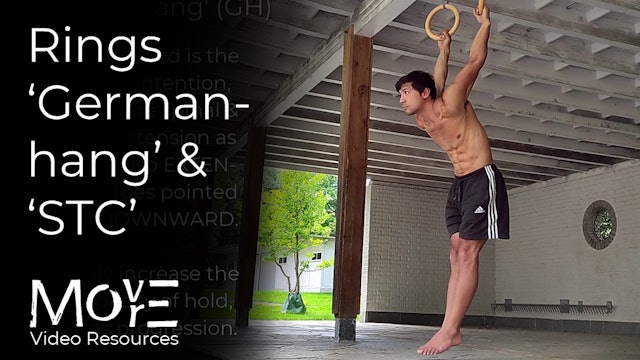SAS pull (horizontal)
When pulling from a hanging position/lowering from an inverted-hang with straight-arms (SA), the body changes orientation in space (closed kinetic-chain movement) toward HORIZONTAL. This is regardless of whether working in SA flexion, e.g. ‘Front-lever (FL)’ or extension, e.g. ‘Back-lever (BL)’. The concentric pull/eccentric lowering is therefore classed as being ‘horizontal’, as the range of motion passes through an arc beginning in a VERTICAL body-position (arms aligned either overhead, when hanging, or at the sides, as in an ‘Inverted-hang’) and gradually increases in intensity until the maximal point of the strength curve, with the body in a HORIZONTAL position.
For this reason, optimal position in all ‘F/BL’ forms is with the hips held in isometric horizontal-alignment with the shoulders. Notably, this range (all the way from “vertical” to “horizontal”) is distinctly greater than in SAS “push” contexts which distinguish between horizontal “pushing”, and then SA overhead “pressing”, the latter of which is given dedicated attention in ‘Press-handstand’ contexts.
LEARN MORE (subscriber-only):
https://drive.google.com/file/d/18GwStXGmIhQaM4xi8Cu9VYC8SpLlpYHA/view?usp=drive_link
-
Rings ‘Knee-raise’ to ‘Toes to rings’
THE WHAT & HOW:
Linear progressions for developing strength, patterning, and familiarity with straight-arm pulling on the gymnastics rings, affecting both straight-arm scapular-strength (SASS) and straight-arm strength (SAS).Along with variations of ‘Knee-to-bar’, this conditioning context emph...
-
From knee-raise to knee-to-bar
THE WHAT & HOW:
Linear progressions for developing strength & patterning for straight-arm pulling, incorporating both straight-arm scapular-strength (SASS) and straight-arm strength (SAS).Particularly from the initial 'Knee-raise' progression, the ultimate objective should be kept in mind throu...
-
Rings 'roll-out'
THE WHAT:
A simple & convenient global-stability drill performed with the gymnastics rings. Its optimal execution relies on an EMBODIED understanding of the "hollow-body" form, namely sustaining a strong 'neutral' spine-position through conscious posterior pelvic-tilt ('PPT') & supported by activ... -
Floor rings 'Inverted-hang' (IH)
THE WHAT:
The 'Inverted-hang' (IH) is perhaps the most fundamental form to learn as a "true-beginner" on the gymnastics rings, regardless of age or capacity. If you leave your rings hanging in a park, a child, or group of kids, will inevitably surround them and begin playing.If you observe, the...
-
Fundamental front-lever (FL) variations
THE WHAT:
As a straight-arm strength (SAS) form, the 'Front-lever' (FL) develops the capacity to withstand isometrically & "pull" one’s bodyweight in & out of a position of hanging shoulder-flexion, i.e. with the straight-arms in FRONT of the medial-line of the body.Whilst this has application ...
-
'Bottom-up' & 'Dynamic' FL-pulls
THE WHAT:
As a straight-arm strength (SAS) form, the 'Front-lever' (FL) develops the capacity to withstand isometrically & "pull" one’s bodyweight in & out of a position of hanging shoulder-flexion, i.e. with the straight-arms in FRONT of the medial-line of the body.Whilst this has application ...
-
Auxiliary 'Front-lever' conditioning
THE WHAT:
Two simple conditioning tools for supportive-development of straight-arm pulling and the 'Front-lever' (FL) form. The first - 'Ice-cream makers' - integrates both bent-arm and straight-arm strength (BAS/SAS) by entering/exiting the 'FL' form, providing a moderate forearm strength-develo... -
'Windshield-wipers' (WW) & 'Meathook' (MH)
THE WHAT:
Both contexts exploring hanging transverse-rotation in a "piked" front-lever form, the 'Windshield wipers' (WW) are a patterning & conditioning context, whilst the 'Meathook' (MH) is an isometric-form which might well be classed as a skill.For this reason they cannot really be seen as...
-
Active shoulder-extension
THE WHAT:
An open kinetic-chain context (i.e. the arms are free to move in space) for both range-development and strengthening of shoulder-extension. Whilst closed kinetic-chain, floor-based contexts (such as the 'AG support' and 'Table' holds) do also develop the same range, they express compara... -
Foundational 'back-lever' development
THE WHAT:
As a straight-arm strength (SAS) form, the 'Back-lever' (BL) develops the capacity to withstand & "pull" ones bodyweight in a position of hanging shoulder-extension, i.e. with the straight-arms BEHIND the medial-line of the body.More fundamentally, however, its progressive-development...
-
'German-hang' (GH) & 'Skin the cat' (STC) development
THE WHAT:
The 'German-hang' (GH) and 'Skin the cat' (STC) are hanging shoulder-extension forms, meaning that the bodyweight is suspended from an anchor-point (here a bar) with the arms BEHIND the mid-line of the body. The main difference between the two variations is that the 'GH' emphasises an i... -
Rings 'German-hang' (GH) & 'Skin the cat' (STC)
THE WHAT:
The 'German-hang' (GH) and 'Skin the cat' (STC) are hanging shoulder-extension forms, meaning that the bodyweight is suspended from an anchor-point (here, the gymnastics rings) with the arms BEHIND the mid-line of the body. The main difference between the two variations is that the 'GH'... -
'Back-lever' (BL) progressions
THE WHAT:
As with all other bodyweight-strength 'lever' forms, intensifying the 'Back-lever' is done simply through manipulation of 'mechanical-dis/advantage', namely increasing the 'load-arm' (i.e. the body) by extending the legs further from the body.Progressions here begin where 'foundationa...
-
Back-lever (BL) 'pulls' (conditioning context)
THE WHAT & HOW:
A conditioning context for the fundamental 'Back-lever' (BL) form, performed on the gymnastics rings. As with the foundational 'Skin the cat' (STC), the 'pulls' context here emphasises the more dynamic motion of pulling "in" and "out" of the BL, rather than the isometric-hold. It ... -
'Supinated' back-lever (BL) progressions
THE WHAT & HOW:
A 'supinated' back-lever variation (palms facing DOWN toward the floor in the hold position) in which the medial (insides) of the elbows are exposed to greater stress than in the 'pronated' variation.Due to the arms being more in a position of EXTERNAL-rotation, the shoulders ar...

















